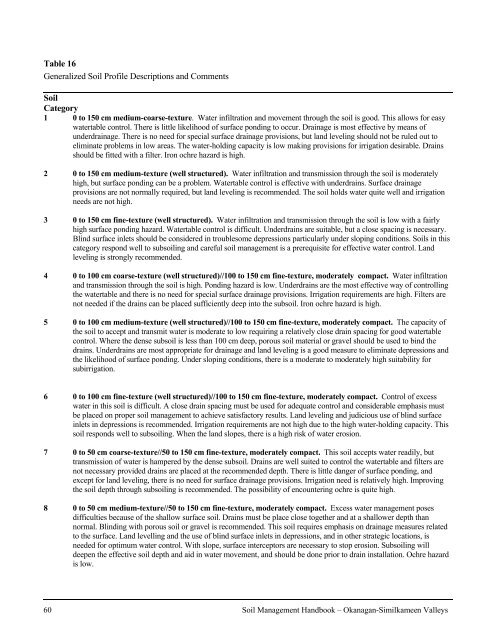Soil Management Handbook - Ministry of Agriculture and Lands
Soil Management Handbook - Ministry of Agriculture and Lands
Soil Management Handbook - Ministry of Agriculture and Lands
Create successful ePaper yourself
Turn your PDF publications into a flip-book with our unique Google optimized e-Paper software.
Table 16<br />
Generalized <strong>Soil</strong> Pr<strong>of</strong>ile Descriptions <strong>and</strong> Comments<br />
<strong>Soil</strong><br />
Category<br />
1 0 to 150 cm medium-coarse-texture. Water infiltration <strong>and</strong> movement through the soil is good. This allows for easy<br />
watertable control. There is little likelihood <strong>of</strong> surface ponding to occur. Drainage is most effective by means <strong>of</strong><br />
underdrainage. There is no need for special surface drainage provisions, but l<strong>and</strong> leveling should not be ruled out to<br />
eliminate problems in low areas. The water-holding capacity is low making provisions for irrigation desirable. Drains<br />
should be fitted with a filter. Iron ochre hazard is high.<br />
2 0 to 150 cm medium-texture (well structured). Water infiltration <strong>and</strong> transmission through the soil is moderately<br />
high, but surface ponding can be a problem. Watertable control is effective with underdrains. Surface drainage<br />
provisions are not normally required, but l<strong>and</strong> leveling is recommended. The soil holds water quite well <strong>and</strong> irrigation<br />
needs are not high.<br />
3 0 to 150 cm fine-texture (well structured). Water infiltration <strong>and</strong> transmission through the soil is low with a fairly<br />
high surface ponding hazard. Watertable control is difficult. Underdrains are suitable, but a close spacing is necessary.<br />
Blind surface inlets should be considered in troublesome depressions particularly under sloping conditions. <strong>Soil</strong>s in this<br />
category respond well to subsoiling <strong>and</strong> careful soil management is a prerequisite for effective water control. L<strong>and</strong><br />
leveling is strongly recommended.<br />
4 0 to 100 cm coarse-texture (well structured)//100 to 150 cm fine-texture, moderately compact. Water infiltration<br />
<strong>and</strong> transmission through the soil is high. Ponding hazard is low. Underdrains are the most effective way <strong>of</strong> controlling<br />
the watertable <strong>and</strong> there is no need for special surface drainage provisions. Irrigation requirements are high. Filters are<br />
not needed if the drains can be placed sufficiently deep into the subsoil. Iron ochre hazard is high.<br />
5 0 to 100 cm medium-texture (well structured)//100 to 150 cm fine-texture, moderately compact. The capacity <strong>of</strong><br />
the soil to accept <strong>and</strong> transmit water is moderate to low requiring a relatively close drain spacing for good watertable<br />
control. Where the dense subsoil is less than 100 cm deep, porous soil material or gravel should be used to bind the<br />
drains. Underdrains are most appropriate for drainage <strong>and</strong> l<strong>and</strong> leveling is a good measure to eliminate depressions <strong>and</strong><br />
the likelihood <strong>of</strong> surface ponding. Under sloping conditions, there is a moderate to moderately high suitability for<br />
subirrigation.<br />
6 0 to 100 cm fine-texture (well structured)//100 to 150 cm fine-texture, moderately compact. Control <strong>of</strong> excess<br />
water in this soil is difficult. A close drain spacing must be used for adequate control <strong>and</strong> considerable emphasis must<br />
be placed on proper soil management to achieve satisfactory results. L<strong>and</strong> leveling <strong>and</strong> judicious use <strong>of</strong> blind surface<br />
inlets in depressions is recommended. Irrigation requirements are not high due to the high water-holding capacity. This<br />
soil responds well to subsoiling. When the l<strong>and</strong> slopes, there is a high risk <strong>of</strong> water erosion.<br />
7 0 to 50 cm coarse-texture//50 to 150 cm fine-texture, moderately compact. This soil accepts water readily, but<br />
transmission <strong>of</strong> water is hampered by the dense subsoil. Drains are well suited to control the watertable <strong>and</strong> filters are<br />
not necessary provided drains are placed at the recommended depth. There is little danger <strong>of</strong> surface ponding, <strong>and</strong><br />
except for l<strong>and</strong> leveling, there is no need for surface drainage provisions. Irrigation need is relatively high. Improving<br />
the soil depth through subsoiling is recommended. The possibility <strong>of</strong> encountering ochre is quite high.<br />
8 0 to 50 cm medium-texture//50 to 150 cm fine-texture, moderately compact. Excess water management poses<br />
difficulties because <strong>of</strong> the shallow surface soil. Drains must be place close together <strong>and</strong> at a shallower depth than<br />
normal. Blinding with porous soil or gravel is recommended. This soil requires emphasis on drainage measures related<br />
to the surface. L<strong>and</strong> levelling <strong>and</strong> the use <strong>of</strong> blind surface inlets in depressions, <strong>and</strong> in other strategic locations, is<br />
needed for optimum water control. With slope, surface interceptors are necessary to stop erosion. Subsoiling will<br />
deepen the effective soil depth <strong>and</strong> aid in water movement, <strong>and</strong> should be done prior to drain installation. Ochre hazard<br />
is low.<br />
60 <strong>Soil</strong> <strong>Management</strong> <strong>H<strong>and</strong>book</strong> – Okanagan-Similkameen Valleys
















